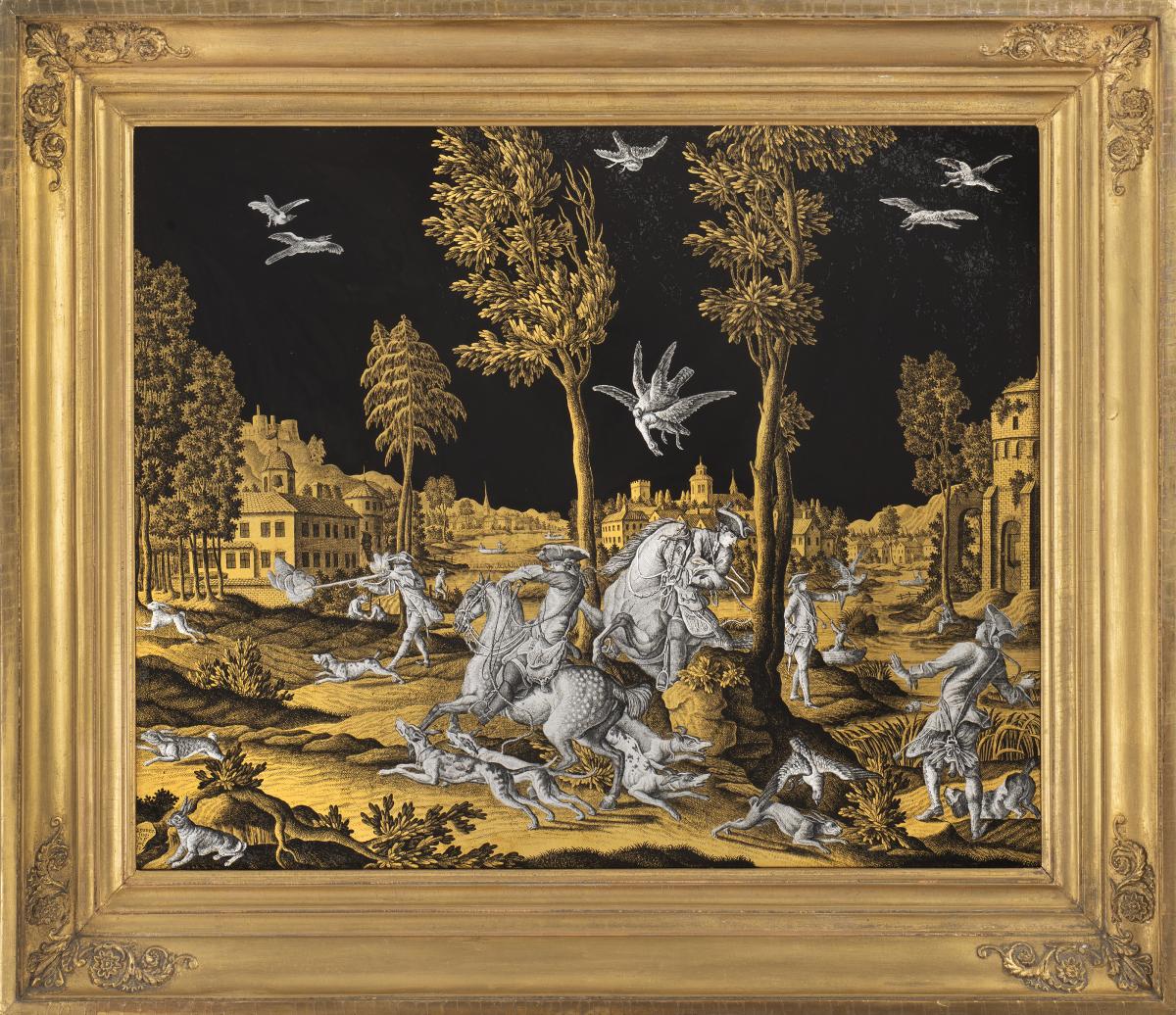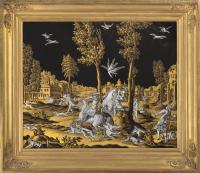

Price on application
This object is eligible for a Certificate of BADA Provenance
The BADA Standard
- Since 1918, BADA has been the leading association for the antiques and fine art trade
- Members are elected for their knowledge, integrity and quality of stock
- Our clients are protected by BADA’s code of conduct
- Our dealers’ membership is reviewed and renewed annually
- Bada.org is a non-profit site: clients deal directly with members and they pay no hidden fees
Jonas Zeuner (Kassel 1727-1814 Amsterdam) - A Verre Églomisé Gold and Silver Reverse Engraved Picture on Glass Depicting a Hunting Scene.
Netherlands, Signed and Dated Zeuner Inv: Den 17 Mart 1770.
The work showing hawking, duck shooting and hare coursing in one scene is composed after elements from several prints in a 25-sheet series ‘Hunters and Falconers with their devices', published around 1764 by Johann Elias Ridinger (Augsburg 1731-1780 Augsburg) in an early 19th century Dutch gilt frame.
The central figure on the horse is depicted in another picture by Zeuner after Ridinger titled ‘Windhetzer’ (Windchaser) and is illustrated in Wolfgang Steiner, Goldglanz un Silberpracht – Hinterglasmalarei aus vier Jahrhunderten (Gold shine and silver splendor. Reverse glass painting from four centuries. Berlin, Munich: German art publisher, 2015 – p. 119).
The popularity and re-interpretation of subjects from engravings such as these is reflected in a porcelain representation of the same figure by Karl Gottlieb Lück, created in 1771.
A pair of verre églomisé hunting scenes by Zeuner after one of the Ridinger prints which include one of the hunters in this composite scene sold at Christie's New York, 7th May 2020 (lot 239).
A pair of works by Zeuner depicting two scenes in Utrecht – a view of the Maliebaan and a view of the Maliebrug with the house 'Bellevue' (each 33.2 x 42.3 cm) sold at Christie’s in New York, 25 January 2023 for $163,800 (lot 64).
Rudy Eswarin makes some interesting observations on Zeuner’s method of working and selling his pictures. It seems likely that such pictures were commissioned for a specific client or produced for a dealer because, as Eswarin point out ‘The special relationship between the engraver of gold leaf and the supplier of the metal is obvious. In his own best interest, the dealer would have acted as a contact point representing his client, the artist. Since the financial outlay required to obtain the materials was probably substantial, a credit facility might have further strengthened the bond….The possibility that Zeuner produced speculative work and had it on display for sale in a shop, must be discounted… The subjects of Zeuner’s better engravings are too specific to be a random choice with an eye to popular appeal. Some pictures were occasionally duplicated, presumably by desire of another client, and minor changes were always made. It must be remembered that each engraving was individually produced from the start, making the exact duplication impossible. This could have provided Zeuner with a strong sales point by adding uniqueness to the impressive visual qualities of the rich materials.’ 'A Group of Portraits by Zeuner' Journal of Glass Studies, vol. 19, 1977, pp. 127–33.
Jonas Zeuner (Kassel 1727-1814 Amsterdam) began his professional career in Germany in the military and in connection with his marriage in 1750, when he settled in Amsterdam, was given the profession of gunner. There is no information about his training as a reverse glass painter. He is the most well-known reverse glass painter from the period. His first recorded works date from 1770 onwards, making this example one of his earliest. Countering the colourful and florid baroque and rococo styles, his gold and silver leaf etchings on glass became highly valued in Dutch society. He worked in Amsterdam until his death in 1814 although he is known to have stayed in London some time between 1800 and 1810, where he took part in the 1778 exhibition of the Society of Artists and produced a number of English landscapes using the verre églomisé technique. A catalog raisonné of Jonas Zeuner was published in 1994 (Sprenkels-Ten Horn, J. (1994). Jonas Zeuner 1727-1814: zijn wereld weerspiegeld in zilver en goud. Abcoude: Uniepers.). He also created works based on engravings by Jan de Beyer (1703-c. 1780), Simon Fokke (1712-1784), and Wiebrand Hendriks 1744-1831.A total of around 190 reverse glass paintings (rear glass etchings in gold and silver leaf) by him are known and examples of his works can be found in the Centraal Museum, Utrecht, the Corning Museum of Glass and the Rijksmuseum.
Verre églomisé is a technique where gold and silver leaf is applied to glass using a gelatine adhesive and a design is etched using a fine needle. To protect the design, a layer of pigment is applied over the metal leaf, often using oil paint for the sky. The image is then viewed from the reverse and creates a mirrored effect.
On Zeuner’s use of the technique and the inherent difficulties it presents, Eswarin explains: ‘In common with reverse painting on glass, no corrections can be made on the engraving, and the gold leaf is somewhat more tricky to handle. The opaque properties of the material do not permit the use of a pattern laid under the glass, and the drawing must be almost imperceptibly traced or transferred by other means onto the work area. The lines are then impressed or cut into the metal with the sharp point of a needle fastened in a holder…After work on the foil is completed, the back of the panel is covered with paint or coloured lacquer for contrast and protection. This coating is seen behind the linework of the engraving, and the effect is not unlike that of a print on a gold background.’ (Rudy Eswarin, 'A Group of Portraits by Zeuner.' Journal of Glass Studies, vol. 19, 1977, p. 130).
‘To transfer the drawing onto the work surface and simultaneously achieve the required size changes, Zeuner most likely used the camera obscura…Drawing directly on the metal duplicates the print position on the back, and when the engraving is finished and viewed from the other (face) side, the image appears with left and right reversed.’ (ibid, p. 133).
Thomas Coulborn & Sons previously sold a pair of pictures by Zeuner, signed and dated 1786, 24 x 30cm, depicting winter scenes after Jean-Baptiste Tilliard and Jan de Beijer.
Dimensions
46 x 56 cmStock number
7053The BADA Standard
- Since 1918, BADA has been the leading association for the antiques and fine art trade
- Members are elected for their knowledge, integrity and quality of stock
- Our clients are protected by BADA’s code of conduct
- Our dealers’ membership is reviewed and renewed annually
- Bada.org is a non-profit site: clients deal directly with members and they pay no hidden fees


